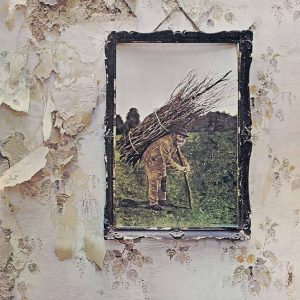
Led Zeppelin released their fourth studio album, untitled but commonly called Led Zeppelin IV, back in 1971 with a simple but mysterious album cover: a bearded man hunched beneath a large bundle of sticks secured over his back. Now, over half a century later, that man and his story have been revealed.
Produced by guitarist Jimmy Page, the contents of Led Zeppelin IV are perhaps most famous for boasting the beloved “Stairway to Heaven,” regarded to this day as one of the greatest rock songs of all time. The album was mostly created within a workhouse in the countryside, which may set a perfect, rustic precedent as we at last learn about the stick man, Lot Long.
The Stick Man from ‘Led Zeppelin IV’ has been identified as a man named Lot Long

Researcher Brian Edwards works with the University of West England’s Regional History Center; it was he who put a potential name to this famous man after rediscovering the old black and white photograph. Handwritten on the picture were the words “A Wiltshire Thatcher.” This photo was found within an album called “Reminiscences of a visit to Shaftesbury. Whitsuntide 1892. A present to Auntie from Ernest.”
RELATED: Post-Band Life Of The Living Members Of Led Zeppelin, Years Later
The photo is believed to be an original because of a thumbprint in the corner. Between the name Ernest and a handwriting match online, the photographer was identified as Victoria photographer Ernest Howard Farmer.
The Wiltshire Museum revealed Edwards’ findings in a statement released on Wednesday. These findings come just a few days after the 52nd anniversary of the album’s release on November 8, 1971.
Meet the Stick Man, identified at last
Mystery figure on cover of Led Zeppelin IV revealed to be a Wiltshire thatcher. Discovered by Brian Edwards, one of our members and now in our collections. To be featured in an exhibition next year. Find out more …@ledzeppelin @ledzepnews https://t.co/kB6XsBCsC1 pic.twitter.com/EDEKWhCk5U
— Wiltshire Museum (@WiltshireMuseum) November 8, 2023
The Regional History Center believes that band leader Robert Plant found the colored version of the original photograph in an antique shop in Berkshire, southern England, not far from Jimmy Page’s house.
“It is fascinating to see how this theme of rural and urban contrasts was developed by Led Zeppelin and became the focus for this iconic album cover 70 years later,” mused museum director David Dawson.

Those themes are perfectly embodied in the photograph and its star, Lot Long, sometimes nicknamed Longyear. This man was born in Mere, Wiltshire, in 1823. He lived in a small cottage and became a widower by the time the photo was taken and ultimately died in 1893.
The original black and white photograph will be displayed at Wiltshire Museum in the spring of 2024.

